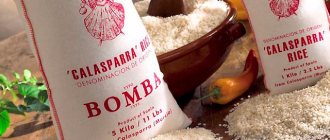People began using spices when cooking meat several centuries ago, noticing that a dish prepared with spices lasts longer, becomes tastier and more aromatic. In the south, where the climate is hot, meat is poorly stored, but a lot of different herbs grow, so spices are used more often.
In ancient times in Europe, spices played a very important role. They were a very valuable and expensive product and were even a trade “currency”. Not everyone could afford them. The search for spices became the impetus for sea voyages.
The beneficial effects of spices on the human body have been proven for a long time. They have a warming effect, have a positive effect on our mood, increase vitality, and improve digestion. They also contain many minerals and trace elements. The main advantage of spices is their ability to kill pathogenic bacteria and disinfect food.
The peculiarity of spices is that they are added in small quantities. When making minced meat, various fillings, seasonings, they are added immediately; when stewing, boiling, frying, they are added to the dish before serving or a minute before the end of cooking. Seasonings are actively used in food preservation.
Peppercorns
It comes in white, pink, black and green. When ground, it is used for frying shish kebab, meat, during stewing and baking. Peppercorns are used when cooking soups and broths. Paprika is made from red sweet peppers. This is a brightly colored seasoning, sweet, with a slight bitterness. Various sauces for meat are made from hot peppers.
Seasonings for sauces served with beef
The correct choice of sauces and seasonings that are served with ready-made beef dishes is also important.
- Pepper sauce goes best with beef steak. It may contain only black and allspice, or it may have a richer composition, including pink pepper and coriander.
- One of the most suitable seasonings for beef is losigian. It consists of hot pepper, garlic, vinegar and vegetable oil.
- If you are a fan of Asian cuisine, you can eat beef with soy sauce seasonings. They can include hot pepper and honey.
- Pepper and tomato sauces are also suitable for beef. An excellent choice would be Caucasian adjika or Bulgarian lyutenitsa.
- Mustard, both Russian and milder French, also goes well with beef.
Horseradish is considered an ideal complement to pork, but it also works well with beef. It is important to remember that horseradish root darkens quickly. To prevent it from acquiring an unappetizing appearance, it is mixed with sour cream immediately after grinding. You can also serve the meat with horseradish - an appetizer made with horseradish and tomatoes.
The best spices for meat
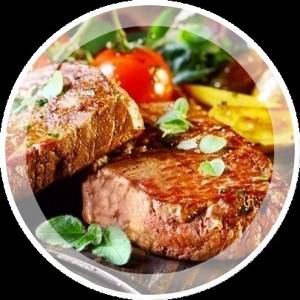
Features of use and benefits of natural seasonings
Properly selected and combined spices have a beneficial effect on health.
Some recipes eliminate the salt content, which can be important when following a diet.
The meat does not lose its organoleptic characteristics, becomes tasty and aromatic and acquires the notes that spices impart to it.
How to use spices for cooking meat correctly?
Spices for meat are used as follows:
- When cooking hot food as a result of frying, boiling, stewing, seasonings are added 1 minute before the end or to the finished dish.
- if other processing is intended, for example, cold smoking, spices are introduced at the beginning.
- It is permissible to put spices into minced meat, prefabricated meat fillings, and offal.
Folk recipes
For sore throat:
- brew thirty grams of dry or fresh leaves of the plant with a glass of boiling water;
- insist;
- rinse with warm tincture several times a day.
For dry cough:
- pour fifteen grams of dry leaves into a glass of boiling water;
- insist;
- take a tablespoon every ten to fifteen minutes.
To strengthen the immune system and as a tonic drink:
- brew the plant like tea;
- We accept during the day.
From helminths:
- brew twenty-five grams of the plant with a glass of boiling water;
- we drink at night.
To improve the functioning of the intestines and stomach:
- Boil ten grams of the plant in a glass of water for two minutes;
- let it brew;
- filter;
- take three times before meals.
Contraindication and harm
Due to the large number of compounds included in essential oils, this plant is not 100% harmless and safe. It has a number of contraindications and you shouldn’t get too carried away with it, both during treatment and when used in cooking.
Can not use:
- people suffering from stomach and duodenal ulcers;
- for cardiovascular diseases during exacerbation;
- for hypertension and atherosclerosis;
- for kidney and liver diseases;
- for individual intolerance:
- pregnant and nursing mothers;
- small children.
Use in cooking
Savory is a plant with a powerful aroma, piquant, spicy taste with slight notes of ginger.
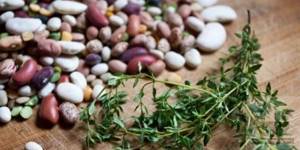
It goes well with dishes made from vegetables, beans and beans, and mushrooms. Savory is also good in combination with marjoram and oregano for meat dishes and game.
Housewives add it to canned fish and when marinating fish.
Dried leaves of the plant are suitable for fatty and difficult to digest foods.
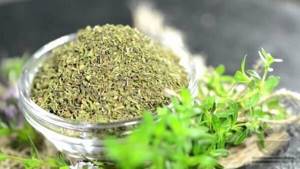
A very tasty and healthy tea is brewed from the spicy herb.
You will find savory in seasonings: from Georgian cuisine - hops-suneli, from French cuisine - Provençal herbs, from Italian cuisine - Italian herbs.
Note to the owner.
When preparing dishes, herbs should be used with caution so that its taste does not dominate everything else. And it is recommended to add it at the end of cooking without rubbing the leaves, otherwise you risk spoiling your dish with bitterness.
What can you substitute for savory in a recipe?
If you don’t have spicy herbs on hand, it doesn’t matter. Savory goes well and can be replaced with sage, thyme, marjoram or black pepper.
Savory or thyme?
Many people wonder: are they the same plant or different? The confusion arises due to the consonance of names.
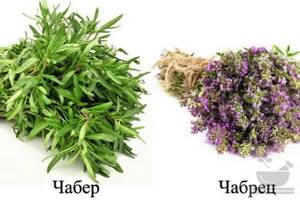
They are actually two different plants.
Although they have a lot in common:
- belong to the same plant family (Labiaceae);
- both are considered medicinal and herbal plants;
- both have a fragrant aroma and are used as seasonings in cooking.
The best spices for cooking meat and their brief characteristics
Video about what spices to use for cooking meat
Start your acquaintance with meat spices with this very interesting and useful video.
All types of Pepper
This is one of the most common seasonings. Pepper vines grow in white, black and green types.
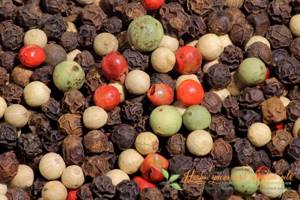
After flowering, the plant develops fruits that, when ripe, acquire the appropriate color. Freshly ground product has the best taste and aroma.
Green
These are unripe fruits that have a unique aroma, mild taste and freshness. In Russia, the spice is available in the form of dry peas and in canned form, where it is in a solution of wine vinegar. This is a good solution for liver, beef, pork, and lamb.
Black
They are also unripe fruits that have an intense, pungent flavor. It is acceptable to use dried peas, ground or chopped pepper - any seasoning can be successfully combined with various types of meat and stimulates the digestion of food.
White
Almost ripe, the hottest fruits containing a large amount of essential oils. Adding this seasoning to food relieves congestion in the intestines and improves the taste of liver and minced meat.
Pink
A spice with a sweetish taste that works great with poultry, veal, and pork. The spice is available in ground and dried form. The taste of pink pepper is reminiscent of coriander.
Cayenne
A bright red spice made from ground chili seeds. This hot spice can be dry ground or fresh. In terms of its effect on the body, it increases blood circulation. In cooking - suitable for grilled pork and poultry dishes.
Chile
This is a traditional spice for Mexican cuisine and oriental dishes. It is known to have an analgesic effect. In our country, chili is available in fresh or dry form. This is the highlight of hot lamb and beef stews.
Red paprika
The sweetish taste and intense red color help to recognize paprika among other seasonings. It works great in mixtures for marinating meat and is combined with poultry, game, minced meat, and pork.
Allspice
Allspice peas with an intense aroma are great in soups and vinegar marinades. The best chefs use it to prepare dishes from all types of meat, including game.
Other seasonings suitable for meat
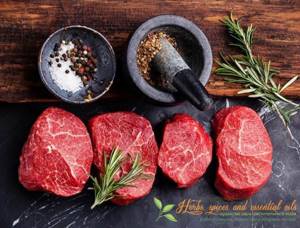
Brief characteristics of other seasonings:
- Cumin . Intensely flavored seeds suitable for cooking chicken and lamb.
- Cumin . Seeds with sweetish-spicy notes. Cumin works great with liver, chicken and lamb.
- Cardamom . Spicy with a warm aroma, the spice is introduced into pork, poultry, and lamb dishes and is used in the preparation of oriental recipes.
- Cinnamon . A spicy-sweet spice that improves and saturates the taste of pork, lamb and beef.
- Carnation . An intensely flavored seasoning used in many marinades containing vinegar.
- Ginger . The fresh root does not lose its taste and is good with pork, lamb, and chicken.
- Turmeric . The sour-spicy, bitter taste is surprisingly organic in stews, sauces, marinades, and pork.
- Anise . In whole or ground form, the spice is a component of Chinese and Indian cuisine. With her participation, you can get decent dishes - cooked in a wok, as well as sauces and marinades.
- Tarragon. The spice has delicate, fresh notes and can be used fresh or dried with beef, lamb, and poultry.
Use in cooking
Being a universal seasoning in its taste properties, savory is widely used for preparing first and second courses and even drinks. This spice, with its delicate taste and aroma, will perfectly complement any dish, adding a spicy note to it.
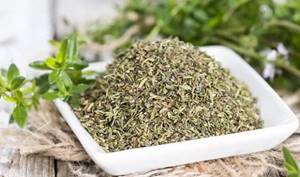
Speaking, for example, about main courses, savory seasoning goes well with all types of legumes:
- peas;
- beans;
- lentils
The spice of savory also perfectly complements egg and cabbage dishes. Fresh shoots of the plant are used for pickling vegetables, mushrooms, and sauerkraut. Dried savory is also good for frying fish, preparing various sauces, appetizers, and salads.
The spice will add a piquant taste to marinated meat, chicken, and fish. For example, marinated herring goes well with this seasoning. It gives the fish not only a spicy aroma, but also has a bactericidal effect. Therefore, it is also recommended to add this seasoning when canning vegetables, in order to avoid swelling of the lids and spoilage of the products.
In addition to its independent use, savory goes well with herbs and spices such as:
- oregano and thyme;
- rosemary and cumin;
- parsley and bay leaf;
- garlic and paprika.
And if you don’t have savory on hand when preparing a dish, you can try to reproduce its taste by improvising with spices such as thyme, sage, and mint.
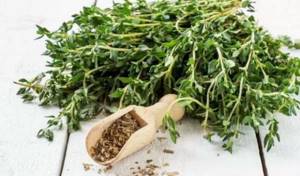
However, you need to add savory in a reasonable amount, as it has a tonic effect.
It is also recommended that this seasoning be used with caution by people:
- suffering from cardiac arrhythmia;
- peptic ulcer of the stomach and duodenum;
- thyroid dysfunction;
- during pregnancy and lactation.


